Documentos
Rigchema
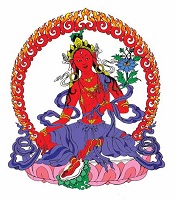 Rigchema, sua cor é muito vermelha escura, quase castanha. Ela segura um arco e uma flecha em cima de um lótus e sua atividade é convocar e capacitar tudo. Ela é vitoriosa em três reinos: o reino do desejo, o domínio da forma (“direção”) e o reino sem forma (“espaço”).
Rigchema, sua cor é muito vermelha escura, quase castanha. Ela segura um arco e uma flecha em cima de um lótus e sua atividade é convocar e capacitar tudo. Ela é vitoriosa em três reinos: o reino do desejo, o domínio da forma (“direção”) e o reino sem forma (“espaço”).
[products_slider title=”” per_page=”12″ featured=”no” latest=”no” best_sellers=”no” on_sale=”no” orderby=”menu_order” order=”desc” layout=”default” category=”tara-branca, tara-verde, tara-vermelha, ” ]
Prece de Refúgio e Bodhichita
[products_slider title=”” per_page=”12″ featured=”no” latest=”no” best_sellers=”no” on_sale=”no” orderby=”menu_order” order=”desc” layout=”default” category=”livros, ” ]
DZA HUNG BAM HO
ཛཿཧཱུྃ་བཾ་ཧོཿ
dza hung bam ho
Mantra of the Four Gate Keepers (dza hung bam ho)
jaḥ hūṃ baṃ hoḥ
Pronounced “dza hung bam ho” by Tibetans.
- The syllable jaḥ is white and goes to the eastern gate, where it takes the form of a white goddess holding an iron hook in her right hand.
- The syllable hūṃ is yellow and streams out to the southern gate, where it takes the form of a yellow goddess holding a lasso in her right hand.
- The syllable baṃ is red and goes to western gate, where it takes the form of a red goddess holding an iron chain in her right hand.
- The syllable hoḥ is green and goes to the gate in the north, where it takes the form of a green goddess holding an bell in her right hand.
If it was a wrathful practice, ” DZA HUNG BAM HO ” would represent the activity of the hook, noose, chain, and bell, but in the peaceful practice:
“DZA” signifies “summoning” – all the lights coming from the 3 places invoke the wisdom-deities to come into space before one;
“HUNG” means “remaining” or “residing” – the wisdom-deities, whom one has invited, and one’s own visualisation, the commitment-deities, are essentially the same: the essence of the mind of a buddha and of one’s own mind is emptiness and appearance inseparable;
“BAM” signifies “binding” – the wisdom-deities and one’s own commitment-deities become mixed with each other, like water into water;
“HO” means “pleased” – after the wisdom-deities and commitment-deities have blended, they feel great joy and happiness at being able to accomplish the benefit of beings.
[products_slider title=”” per_page=”12″ featured=”no” latest=”no” best_sellers=”no” on_sale=”no” orderby=”menu_order” order=”desc” layout=”default” category=”livros, ” ]
Ushnishavijaya
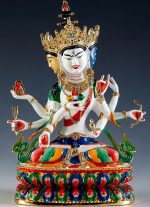 Ushnishavijaya
Ushnishavijaya
(“A Vitoriosa do Ushnisha”; Tibetan: གཙུག་གཏོར་རྣམ་རྒྱལ་མ།, Wylie: gtsug tor rnam rgyal ma, THL: Tsuktor Namgyelma) é um buda da longevidade no Budismo. Ela veste uma imagem de Vairocana no ornamento em sua cabeça. Junto com Amitayus e Tara Branca, she constitui “Os Três Budas de Longevidade” (Tibetan: tse lha nam sum).
“… Ushnishavijaya, a cor de uma lua de outono, com três faces, branco, amarelo e azul e oito mãos. Cada face tem três olhos muito grandes. A primeira mão direita contém um vishvavajra (dorje duplo), a segunda segura um lótus branco com Amitabha, o Buda da família lótus, a terceira mão segura uma flecha e o quarta no gesto de suprema generosidade. A primeira mão esquerda detém um Laço Vajra, a segunda mão segura um arco, a terceira mão está no gesto de conferir proteção e a quarta mão está no gesto de equilíbrio meditativo segurando um vaso de néctar auspicioso. Ela está com sedas e ornamentos de jóias, sentados na postura vajra. “. (Jamyang Kyentse Wangpo, 1820-1892).
Tsuktor Namgyal
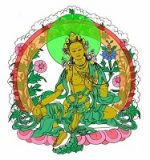 Tsugtor (Tibetan: གཙུག་གཏོར་རྣམ་རྒྱལ་མ།, Wylie: gtsug tor rnam rgyal ma) em tibetano significa o “nó mais alto” sobre o chakra da coroa de um Buda; Esta é uma das trinta e duas marcas de um ser plenamente iluminado. Namgyal ou vijaya significa “vitorioso”. A tradução aproximada, seu nome significa “vitorioso um dos nós superiores”. Esta Tara particular é conhecida como a Tara de longa vida, com a capacidade de fortalecer a força vital, a energia vital e a vitalidade de todos os seres sencientes. Ela também protege os seres de renascer em situações desfavoráveis ou em reinos inferiores.
Tsugtor (Tibetan: གཙུག་གཏོར་རྣམ་རྒྱལ་མ།, Wylie: gtsug tor rnam rgyal ma) em tibetano significa o “nó mais alto” sobre o chakra da coroa de um Buda; Esta é uma das trinta e duas marcas de um ser plenamente iluminado. Namgyal ou vijaya significa “vitorioso”. A tradução aproximada, seu nome significa “vitorioso um dos nós superiores”. Esta Tara particular é conhecida como a Tara de longa vida, com a capacidade de fortalecer a força vital, a energia vital e a vitalidade de todos os seres sencientes. Ela também protege os seres de renascer em situações desfavoráveis ou em reinos inferiores.
5 Buddhas da Meditação
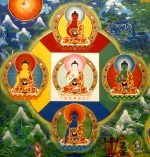 Os Cinco Budas da Meditação (do sânscrito ध्यानि , transl. Dhyani, “concentração”) são os budas principais de cada uma das cinco famílias do budismo tibetano.
Os Cinco Budas da Meditação (do sânscrito ध्यानि , transl. Dhyani, “concentração”) são os budas principais de cada uma das cinco famílias do budismo tibetano.
Os Cinco Budas são:
- Vairochana (ou Samanthabadra), da família Buda;
- Ratnasambhava, da família Ratna (Jóia);
- Amitaba, da família Pema (Lótus);
- Akshobya, da família Vajra (Diamante);
- Amogasidi, da família Karma.
A cada família, é associada uma cor, um animal, um dos cinco elementos e uma direção. Cada buda possui uma consorte, um tipo de sabedoria e está associado a um dos agregados que compõem nosso mundo visível.
[products_slider title=”” per_page=”12″ featured=”no” latest=”no” best_sellers=”no” on_sale=”no” orderby=”menu_order” order=”desc” layout=”default” category=”statue, ” ]
Dhyani Buddhas
 Os Cinco Budas da Meditação (do sânscrito ध्यानि , transl. Dhyani, “concentração”) são os budas principais de cada uma das cinco famílias do budismo tibetano.
Os Cinco Budas da Meditação (do sânscrito ध्यानि , transl. Dhyani, “concentração”) são os budas principais de cada uma das cinco famílias do budismo tibetano.
Os Cinco Budas são:
- Vairochana (ou Samanthabadra), da família Buda;
- Ratnasambhava, da família Ratna (Jóia);
- Amitaba, da família Pema (Lótus);
- Akshobya, da família Vajra (Diamante);
- Amogasidi, da família Karma.
A cada família, é associada uma cor, um animal, um dos cinco elementos e uma direção. Cada buda possui uma consorte, um tipo de sabedoria e está associado a um dos agregados que compõem nosso mundo visível.
[products_slider title=”” per_page=”12″ featured=”no” latest=”no” best_sellers=”no” on_sale=”no” orderby=”menu_order” order=”desc” layout=”default” category=”statue, ” ]4 Incomensuráveis
 As Quatro Qualidades Incomensuráveis – (Tib. ཚངས་པའི་གནས་བཞི་, Wyl. tshangs pa’i gnas bzhi)
As Quatro Qualidades Incomensuráveis – (Tib. ཚངས་པའི་གནས་བཞི་, Wyl. tshangs pa’i gnas bzhi)
- Equanimidade, (Tib. བཏང་སྙོམས་, tangnyom) desejo de que todos os seres sejam libertados do sofrimento, sem nenhuma atitude de apego e aversão;
- Amor, (Tib. བྱམས་པ་, jampa) desejo de que todos os seres possam ser felizes e de que tenham as causas da felicidade.
- Compaixação, (Tib. སྙིང་རྗེ་, nyingjé) desejo de que todos os seres possam ser livres do sofrimento de livres da causa do sofrimento.
- Alegria, (Tib. དགའ་བ་, gawa) desejo de que todos os seres possam ser felizes e de que a felicidade possa sempre aumentar.
Como Praticar: em edição
1. Equanimity
Initially, we need to train the mind in equanimity. The way in which we are currently attached to our friends and aggressive towards our enemies is a fault which comes from failing to examine the situation thoroughly. In reality, today’s so-called “enemies” have, in the course of our many past lifetimes, been dear friends who have helped us enormously. And those whom we currently consider to be our “friends” have been our enemies in past lifetimes, having caused us considerable harm.
The Noble Katyayana said:
- “He eats his father’s flesh, while striking his own mother,
- And cradles in his lap the enemy he killed;
- The wife is gnawing at her husband’s bones.
- Samsara is enough to make you laugh out loud!
Recognize that this bias, which currently causes us to see some people as our friends and others as our enemies, is a result of having fallen under the power of ignorance. Train your mind until you feel a benevolent attitude, like the one you have now for your presentmother and father, for all beings, especially your “enemies” and those who create obstacles for you.
2. Love
Then, since these beings have shown you exactly the same kindness as your current parents, cultivate love for them all and wish them happiness in order to repay their past kindness. Train yourself to be like parents caring for a small child, or a mother bird looking after her young, so that all your actions of body, speech and mind are undertaken only to ensure the happiness and well-being of others.
3. Compassion
Cultivate compassion, which is the wish for beings to be freed from suffering. Imagine a prisoner who is about to be executed, or an animal at the slaughterhouse, and put yourself in their position, or imagine that they are your own dear mother. When you experience an unbearably intense feeling of compassion for them, consider that although the one experiencing such suffering is not actually your mother or father in this lifetime, he or she has been your mother and father countless times throughout the course of your innumerable lifetimes. Practise cultivating this compassion until you feel exactly the same compassion for all sentient beings as you do for your own mother and father.
4. Joy
Whenever you see someone who is wealthy and powerful, and apparently enjoying all the pleasures of the higher realms, or whenever you see someone who possesses the qualities of scriptural learning and realization, do not feel resentful or envious of them, even if you consider them to be an enemy. Instead, feel joyful and make the wish that their riches and power increase even further. And pray that all sentient beings may experience the same kind of good fortune. Train your mind in this way, again and again.
If, when you practise training the mind in these four immeasurables, you proceed gradually—first considering your own parents; then including your friends and relatives; and finally extending the practice to your enemies—you will come to feel the same love and compassion for your enemies as for your parents. This is the measure of your mind training.
[products_slider title=”” per_page=”12″ featured=”no” latest=”no” best_sellers=”no” on_sale=”no” orderby=”menu_order” order=”desc” layout=”default” category=”livros, ” ]As Quatro Qualidades Incomensuráveis
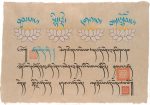 As Quatro Qualidades Incomensuráveis – (Tib. ཚངས་པའི་གནས་བཞི་, Wyl. tshangs pa’i gnas bzhi)
As Quatro Qualidades Incomensuráveis – (Tib. ཚངས་པའི་གནས་བཞི་, Wyl. tshangs pa’i gnas bzhi)
- Equanimidade, (Tib. བཏང་སྙོམས་, tangnyom) desejo de que todos os seres sejam libertados do sofrimento, sem nenhuma atitude de apego e aversão;
- Amor, (Tib. བྱམས་པ་, jampa) desejo de que todos os seres possam ser felizes e de que tenham as causas da felicidade.
- Compaixação, (Tib. སྙིང་རྗེ་, nyingjé) desejo de que todos os seres possam ser livres do sofrimento de livres da causa do sofrimento.
- Alegria, (Tib. དགའ་བ་, gawa) desejo de que todos os seres possam ser felizes e de que a felicidade possa sempre aumentar.
Como Praticar: em edição
1. Equanimity
Initially, we need to train the mind in equanimity. The way in which we are currently attached to our friends and aggressive towards our enemies is a fault which comes from failing to examine the situation thoroughly. In reality, today’s so-called “enemies” have, in the course of our many past lifetimes, been dear friends who have helped us enormously. And those whom we currently consider to be our “friends” have been our enemies in past lifetimes, having caused us considerable harm.
The Noble Katyayana said:
- “He eats his father’s flesh, while striking his own mother,
- And cradles in his lap the enemy he killed;
- The wife is gnawing at her husband’s bones.
- Samsara is enough to make you laugh out loud!
Recognize that this bias, which currently causes us to see some people as our friends and others as our enemies, is a result of having fallen under the power of ignorance. Train your mind until you feel a benevolent attitude, like the one you have now for your presentmother and father, for all beings, especially your “enemies” and those who create obstacles for you.
2. Love
Then, since these beings have shown you exactly the same kindness as your current parents, cultivate love for them all and wish them happiness in order to repay their past kindness. Train yourself to be like parents caring for a small child, or a mother bird looking after her young, so that all your actions of body, speech and mind are undertaken only to ensure the happiness and well-being of others.
3. Compassion
Cultivate compassion, which is the wish for beings to be freed from suffering. Imagine a prisoner who is about to be executed, or an animal at the slaughterhouse, and put yourself in their position, or imagine that they are your own dear mother. When you experience an unbearably intense feeling of compassion for them, consider that although the one experiencing such suffering is not actually your mother or father in this lifetime, he or she has been your mother and father countless times throughout the course of your innumerable lifetimes. Practise cultivating this compassion until you feel exactly the same compassion for all sentient beings as you do for your own mother and father.
4. Joy
Whenever you see someone who is wealthy and powerful, and apparently enjoying all the pleasures of the higher realms, or whenever you see someone who possesses the qualities of scriptural learning and realization, do not feel resentful or envious of them, even if you consider them to be an enemy. Instead, feel joyful and make the wish that their riches and power increase even further. And pray that all sentient beings may experience the same kind of good fortune. Train your mind in this way, again and again.
If, when you practise training the mind in these four immeasurables, you proceed gradually—first considering your own parents; then including your friends and relatives; and finally extending the practice to your enemies—you will come to feel the same love and compassion for your enemies as for your parents. This is the measure of your mind training.
[products_slider title=”” per_page=”12″ featured=”no” latest=”no” best_sellers=”no” on_sale=”no” orderby=”menu_order” order=”desc” layout=”default” category=”livros, ” ]Dharmachakra
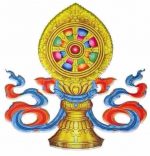 Roda do Dharma ou Dharmachakra Sanskrit: Dharmacakra; Tibetan: ཁོར་ལོ, Wylie: khor lo): representa os ensinamentos do Buda e sua energia de movimento e transformação espiritual.
Roda do Dharma ou Dharmachakra Sanskrit: Dharmacakra; Tibetan: ཁོར་ལོ, Wylie: khor lo): representa os ensinamentos do Buda e sua energia de movimento e transformação espiritual.
“Roda do Dharma” é um símbolo representando o dharma, os ensinamentos do Buddha sobre o caminho para a iluminação. É também algumas vezes traduzida como roda da doutrina ou roda da lei.
É um dos oito símbolos auspiciosos.
[products_slider title=”” per_page=”12″ featured=”no” latest=”no” best_sellers=”no” on_sale=”no” orderby=”menu_order” order=”desc” layout=”default” category=”amuletos-amuletos, ” ]
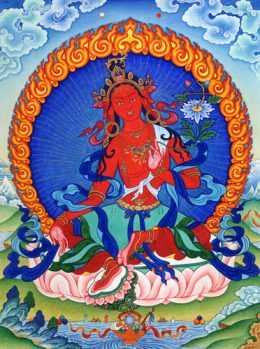
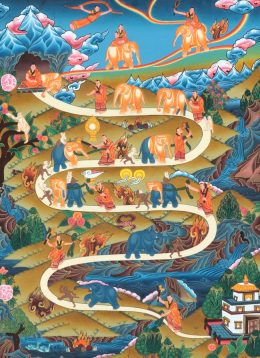
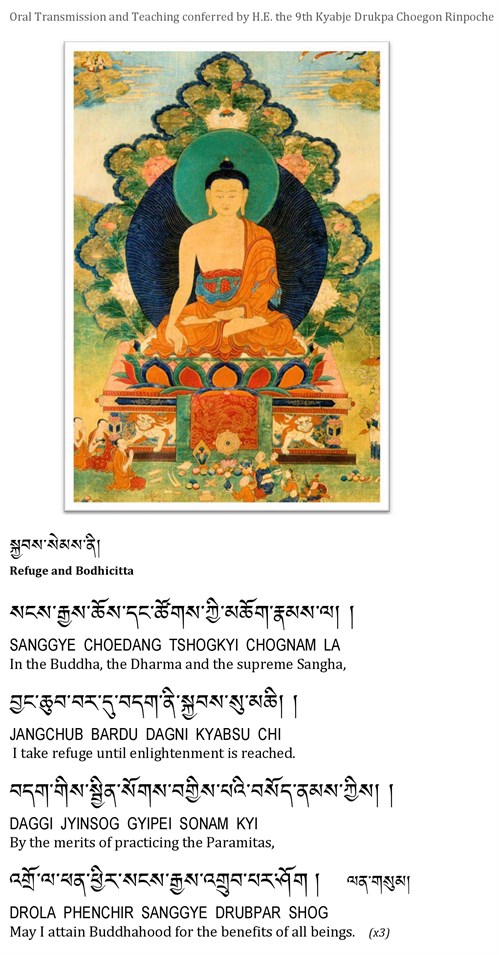
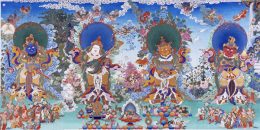
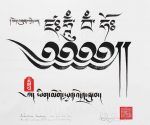
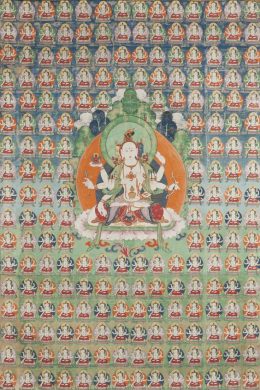
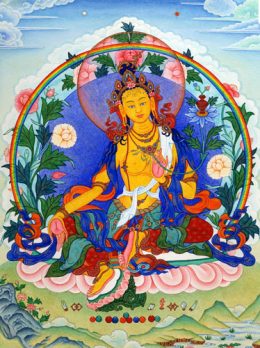
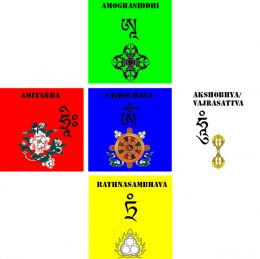
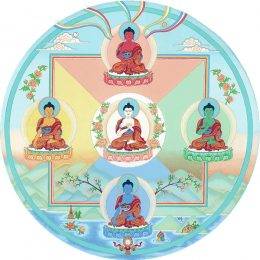
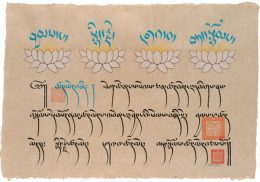
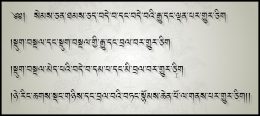
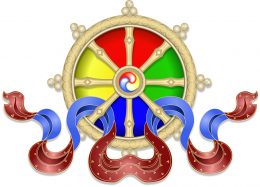
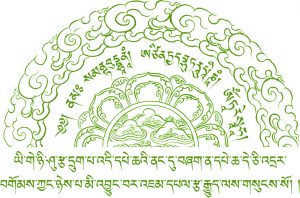
 Cintamani - Meditação e Arte - Copyright 2020 - Todos os direitos reservados.
Cintamani - Meditação e Arte - Copyright 2020 - Todos os direitos reservados.